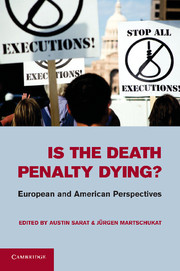Book contents
- Frontmatter
- Contents
- Contributors
- Acknowledgments
- Introduction: Transatlantic Perspectives on Capital Punishment
- PART I WHAT IS A PENALTY OF DEATH: CAPITAL PUNISHMENT IN CONTEXT
- 1 The Green, Green Grass of Home
- 2 Did Anyone Die Here?
- 3 Capital Punishment as Homeowner's Insurance
- Part II ON THE MEANING OF DEATH AND PAIN IN EUROPE AND THE UNITED STATES: VIEWING, WITNESSING, UNDERSTANDING
- Part III ABOLITIONIST DISCOURSES, ABOLITIONIST STRATEGIES, ABOLITIONIST DILEMMAS: TRANSATLANTIC PERSPECTIVES
- Index
1 - The Green, Green Grass of Home
Capital Punishment and the Penal System from a Long-Term Perspective
Published online by Cambridge University Press: 04 February 2011
- Frontmatter
- Contents
- Contributors
- Acknowledgments
- Introduction: Transatlantic Perspectives on Capital Punishment
- PART I WHAT IS A PENALTY OF DEATH: CAPITAL PUNISHMENT IN CONTEXT
- 1 The Green, Green Grass of Home
- 2 Did Anyone Die Here?
- 3 Capital Punishment as Homeowner's Insurance
- Part II ON THE MEANING OF DEATH AND PAIN IN EUROPE AND THE UNITED STATES: VIEWING, WITNESSING, UNDERSTANDING
- Part III ABOLITIONIST DISCOURSES, ABOLITIONIST STRATEGIES, ABOLITIONIST DILEMMAS: TRANSATLANTIC PERSPECTIVES
- Index
Summary
The swan has been KLM's emblem for a long time. In the late 1990s, the airline ran a commercial on Dutch television that showed this bird landing on water at the sound of Tom Jones singing The Green, Green Grass of Home. I was utterly surprised. Although the difference between an execution and a plane crash is obvious, yet the association inescapably caught my mind. Didn't the people at the advertising agency know what the song was about? The combination of “a guard” and “arm in arm we'll walk at daybreak” seemed clear to me, but then I happen to know that executions are often scheduled for the early morning. The phrase in between, that I never heard quite right, turned out to speak of a “sad old padre,” which suggests that the dreamer's death row is in Mexico. Perhaps the film makers had not paid sufficient attention to the text, but their ignorance also testifies to something deeper: European unfamiliarity with the death penalty as opposed to its relative familiarity for Americans.
We know it has not always been like that. The Dutch and other Europeans have come a long way from the time that the very term “the green lawn” (het groene zoodje) referred to the site of the scaffold, visible every day, to their present unfamiliarity. The lynching of the brothers De Witt, moreover, on The Hague's green lawn in 1672, anticipated the alleged association of U.S. popular justice with capital punishment by two centuries.
- Type
- Chapter
- Information
- Is the Death Penalty Dying?European and American Perspectives, pp. 17 - 46Publisher: Cambridge University PressPrint publication year: 2011
- 2
- Cited by



